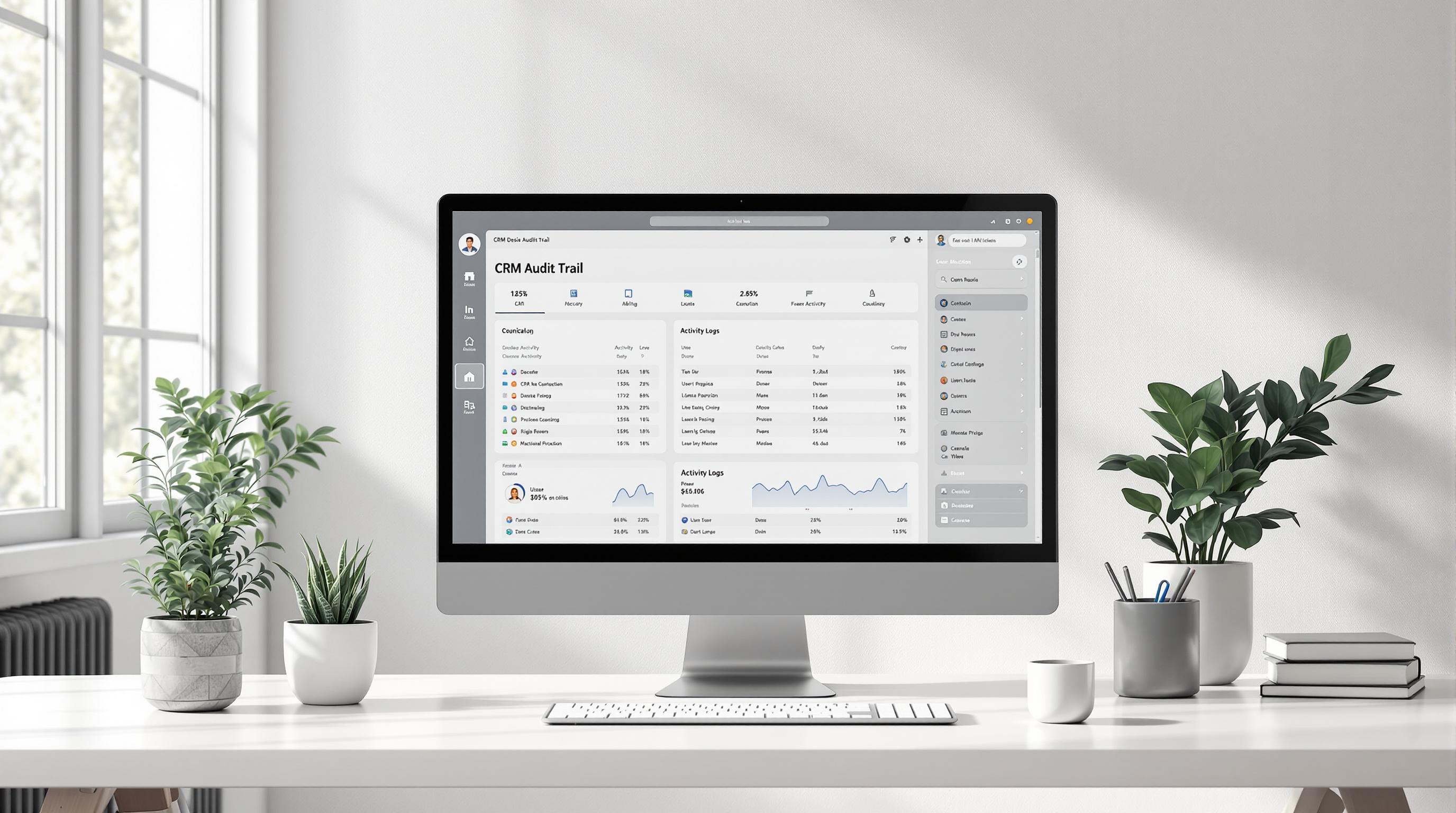To improve your sales performance, focus on these 10 metrics that track activity, efficiency, and outcomes:
- Call Volume: Number of calls made by your team.
- Email Performance: Open rates, click-through rates (CTR), and response rates.
- Meeting Count: Volume, success rate, and meeting-to-opportunity conversion.
- Social Media Activity: Connection rate, engagement score, and profile visit-to-connection ratio.
- Activity Time Analysis: Time spent on productive vs. repetitive tasks.
- Lead Follow-up Speed: Response times for inquiries and follow-ups.
- New Sales Opportunities: Volume, source distribution, and qualification rate.
- Deal Timeline: Average sales cycle length and stalled deals.
- Sales Pipeline Speed: Velocity rate and stage conversion times.
- Close Rate: Percentage of opportunities that result in closed deals.
Quick Overview:
Focus on automation tools like Hatrio Sales to streamline repetitive tasks, track these metrics effectively, and improve overall sales efficiency. Start with call volume and email performance, then expand to other metrics for a comprehensive view of your sales pipeline.
Sales Metrics to Track: The Ultimate Guide
1. Call Volume
Call volume refers to the total number of calls made by your sales team, providing a snapshot of their phone activity and customer interactions.
Monitoring daily calls per sales rep gives you clear data to assess performance and identify trends.
With Hatrio Sales, every call is automatically logged, ensuring precise and reliable records.
2. Email Performance
Email metrics help you understand how well your outreach connects with prospects and drives action.
Here are three key metrics to focus on:
- Open Rates: This shows the percentage of recipients who open your emails. It reflects how compelling your subject lines are and the trustworthiness of your sender reputation.
- Click-Through Rates (CTR): This measures the percentage of recipients clicking on links within your emails, revealing how engaging your content and calls-to-action are.
- Response Rates: This tracks the percentage of recipients who reply to your emails, showing how well your messaging sparks meaningful conversations.
With Hatrio Sales, these metrics are tracked automatically, giving your team the insights needed to adjust and improve outreach in real time.
To improve email performance, try these strategies:
- Test different subject lines to see what drives more opens.
- Use prospect data to personalize your emails and make them more relevant.
- Schedule emails for times when recipients are most likely to engage.
- Segment your email lists to deliver targeted, focused messages.
3. Meeting Count
Tracking meetings helps gauge how engaged prospects are and how efficiently your team is managing the sales process.
Key Meeting Metrics to Watch
-
Meeting Volume
Keep an eye on the total number of meetings and how they're distributed across different stages of your sales pipeline. -
Meeting Success Rate
Measure the percentage of scheduled meetings that actually happen. A high attendance rate typically means your team is qualifying prospects well and clearly communicating value. -
Meeting-to-Opportunity Conversion
Check how many meetings lead to qualified opportunities. This shows how effectively your team identifies and nurtures promising prospects during early interactions.
Using Hatrio Sales for Meeting Insights

Hatrio Sales' meeting tracking features automatically capture key metrics and provide insights like:
- Trends in meeting durations to help with better scheduling
- The balance between introductory and follow-up meetings
- Time gaps between meetings throughout the sales cycle
These insights can guide you in refining your meeting approach for better results.
Tips for Managing Meetings Effectively
- Schedule meetings as soon as possible after initial contact.
- Share a clear agenda and any relevant materials ahead of time.
- Document key outcomes and action items immediately after the meeting.
- Follow up promptly to maintain momentum.
A well-organized tracking system can also reveal problem areas in your sales process. For example, if many meetings aren't turning into opportunities, it might be time to revisit your qualification process or improve how your team prepares for meetings.
4. Social Media Activity
After evaluating meetings and email performance, social media metrics add another layer of insight into sales activity. These metrics reveal how prospects interact with your content and help fine-tune social selling strategies. Together with calls and emails, they provide a clearer picture of your sales pipeline's status.
Key Social Media Metrics to Monitor
- Connection Rate: Tracks how many of your connection requests are accepted, showing how well you're targeting the right prospects.
- Engagement Score: Measures comments, shares, and reactions to assess how relevant your content is and how strong your relationships are.
- Profile Visit-to-Connection Ratio: Examines how often profile views turn into connections, helping you understand your profile's effectiveness.
Using Social Media Data Effectively
Hatrio Sales offers tools to help sales teams make the most of social media data by enabling them to:
- Add valuable details to lead records using social profiles.
- Track how prospects engage across different channels.
- Measure the success of social selling efforts.
- Simplify connection management for better efficiency.
Tips for Tracking Social Media Activity
- Check metrics daily to identify trends and adjust your approach as needed.
- Pay attention to response times - quicker replies often improve conversion rates.
- Focus on content that generates the most engagement and use it to refine your social selling tactics.
Benefits of Automation
Hatrio Sales' automation tools can help by:
- Handling connection management tasks automatically.
- Ensuring consistent engagement with prospects.
- Scaling social selling efforts through automated tracking and interactions.
5. Activity Time Analysis
Analyzing how time is spent can uncover inefficiencies and help improve productivity. By identifying where time is wasted, teams can focus more on activities that directly contribute to revenue growth.
Identifying Time Wasters
Everyday routines can reveal areas where time slips away, such as:
- Manually following up when automation could handle it
- Spending too much time on unqualified leads
- Getting bogged down in administrative work instead of engaging with customers
Addressing these issues often starts with introducing automation.
Automation Solutions
Tools like Hatrio Sales help sales teams save time by:
- Automating drip campaigns to keep communication consistent
- Using lead scoring to prioritize the most promising prospects
- Integrating with CRM systems to reduce time spent on administrative tasks
Practical Time Management Tips
Here are some ways to manage time more effectively:
- Track how long sales activities take to create benchmarks
- Regularly review time allocation to spot inefficiencies
- Prioritize tasks that have the biggest impact on results
These steps can be taken further by automating repetitive workflows.
Streamlining Workflows
Automating routine tasks allows sales teams to focus on building relationships and closing deals, instead of getting stuck in low-value activities.
Measuring the Impact
Efficient time management improves key sales performance metrics. To measure success, compare how much time is spent on customer-facing tasks versus administrative duties. This ensures efforts are concentrated on activities that deliver the best results.
sbb-itb-b22f30c
6. Lead Follow-up Speed
Following up with leads promptly is crucial for turning early interest into successful conversions. A fast response can make a big difference in maintaining momentum and improving outcomes.
Measuring Response Times
Keep track of these key timing metrics to evaluate how quickly your team follows up with leads:
- Initial response time for new leads
- Time between follow-up attempts
- Total time from first contact to qualification
- Average wait time for customer inquiries
These metrics play a major role in determining conversion success, highlighting the importance of quick follow-ups.
Why Speed Matters for Conversions
Responding quickly does more than just show professionalism - it helps sales teams:
- Connect with prospects when their interest is at its peak
- Stay ahead of competitors who may also be reaching out
- Keep the sales process moving forward effectively
Using Automation to Stay Ahead
Automation tools can help ensure consistent follow-up times. By setting up automated drip campaigns, using lead scoring to prioritize high-value prospects, and creating pre-set response templates, your team can focus on building relationships while staying efficient. Tools like Hatrio Sales simplify these processes, making it easier to nurture leads throughout the funnel.
Tips to Improve Follow-up Speed
Here are some practical ways to respond faster:
- Set up automated responses for inquiries that come in after hours
- Use lead scoring to focus on the most promising prospects
- Create templates for frequently asked questions
- Enable mobile notifications so team members can respond quickly, even on the go
Continuously monitor and tweak these strategies to keep improving your follow-up process.
Tracking Performance
Regularly analyze these aspects to identify areas for improvement:
- Response times during business hours
- Coverage gaps during specific periods
- Team members who consistently meet response goals
- Processes that could be fine-tuned for better results
7. New Sales Opportunities
To keep your sales pipeline strong, it's crucial to monitor the creation of new opportunities after ensuring prompt follow-up. These opportunities are key indicators of pipeline health and help forecast revenue.
What Are New Opportunities?
A new sales opportunity represents a potential deal that meets specific criteria. To qualify, it should include:
- Verified contact information
- A confirmed budget
- Identified decision-makers
- An established timeline
- A completed needs assessment
Having a clear definition like this makes it easier to track pipeline growth effectively.
How to Measure Pipeline Growth
Here are a few ways to gauge the growth of your pipeline:
- Weekly Volume: Tracks how many new opportunities are added, showing how effective your lead generation efforts are.
- Source Distribution: Identifies where opportunities are coming from, highlighting the best-performing channels.
- Qualification Rate: Measures the percentage of leads that turn into opportunities, giving insight into lead quality.
- Average Deal Size: Shows the value of new opportunities, helping to predict revenue impact.
Assessing Opportunity Quality
When evaluating potential deals, focus on these factors:
- Company fit and budget: Does the prospect align with your target market?
- Decision timeline: Is there a clear timeframe for making a decision?
- Content engagement: How engaged has the prospect been with your content?
- Prior interactions: What previous contact has occurred, and what does it reveal?
Streamlining with Automation
Tools like Hatrio Sales simplify the process of capturing and enriching prospect data. This includes gathering details like company profiles, professional information, website data, contact details, and industry classification.
"I'm using Hatrio Sales to find email addresses for outbound sales & Email Campaign. Our sales funnels are fully managed by them - from prospecting to qualifying to closing sales." - Hatrio Sales Customer
Tips for Managing Opportunities
To stay on top of your sales opportunities, consider these practices:
- Define clear qualification criteria.
- Use automated lead scoring to prioritize prospects.
- Regularly evaluate the sources of your opportunities.
- Track conversion rates by channel.
- Keep an eye on how long opportunities remain in the pipeline.
Tracking Performance
Consistently monitor these metrics to fine-tune your opportunity management:
- Monthly growth in opportunities: Are you adding enough new deals?
- Average time to qualification: How quickly are leads moving through the process?
- Opportunity-to-win ratio: What percentage of opportunities are turning into closed deals?
- Channel performance: Which sales channels are delivering the best results?
- Lead source quality: Are your lead sources providing high-quality prospects?
8. Deal Timeline
The deal timeline tracks how long it takes to move a prospect from the first interaction to closing a deal. This helps you spot delays and inefficiencies in your sales process.
Here’s what to keep an eye on:
- Average Sales Cycle Length: How long it takes from the first contact to closing the deal.
- Stage Duration: The time prospects spend in each phase of your sales process.
- Stalled Deals: Opportunities that have been inactive for too long.
These metrics work together to give you a clear picture of your pipeline's performance.
If you notice delays in stages like qualification or negotiation, you can pinpoint where improvements are needed. Tools like Hatrio Sales can help by automating lead scoring based on prospect activity, so your team spends time on the most promising leads.
9. Sales Pipeline Speed
Sales pipeline speed tracks how quickly opportunities move through your sales process. It helps you identify slow points and close deals faster.
Key Metrics to Watch
- Velocity Rate: This is the average time deals spend in each stage. For example, if deals spend 3 days in the qualification stage but 5 days in discovery, it highlights potential delays.
- Stage Conversion Time: Measures the time it takes to move leads between stages, such as:
- Initial contact to qualification
- Qualification to proposal
- Proposal to negotiation
- Negotiation to close
- Acceleration Points: Tools like Hatrio Sales analytics can help you spot stages where transitions happen faster, so you can replicate those successful patterns.
By keeping an eye on these metrics, you can make informed changes to speed up your sales process.
How to Improve Pipeline Velocity
Lead scoring, powered by tools like Hatrio Sales, is key to keeping your pipeline moving efficiently. Here are some effective strategies:
- Automate lead qualification and follow-ups to reduce delays.
- Focus on active opportunities by monitoring engagement signals.
- Use automated drip campaigns to keep prospects engaged.
- Enrich lead profiles with additional data for deeper insights.
- Regularly review slow-moving stages and refine your process.
These steps help ensure deals progress smoothly without sacrificing quality.
10. Close Rate
Close rate measures the percentage of opportunities that result in successful deals. Unlike other metrics that focus on process efficiency, this one directly reflects sales effectiveness.
How to Calculate Close Rate
To find your close rate, divide the number of closed-won deals by the total number of opportunities. For instance, if you close 25 deals out of 100 opportunities, your close rate is 25%. A higher close rate means better performance and a stronger sales pipeline.
What Impacts Close Rate?
Two key elements play a role in closing deals:
- Lead Quality: High-quality leads and proper lead scoring increase the likelihood of closing.
- Follow-Up Timing: Consistent and timely follow-ups help keep deals on track.
Boosting Your Close Rate
Want to improve your close rate? Here are two practical steps:
- Use lead scoring to prioritize the best opportunities.
- Automate drip campaigns to ensure timely and consistent follow-ups.
Monitoring your close rate over time can reveal sales trends and pinpoint issues in your process. Tools like Hatrio Sales can simplify lead scoring and follow-ups, helping you close more deals.
Conclusion
Tracking sales activities helps streamline your pipeline and boost growth. By focusing on these 10 key metrics, you can make smarter, data-backed decisions that directly impact revenue.
Implementation Strategy
-
Focus on Key Metrics
Begin with tracking call volume and email performance to gain quick and actionable insights. -
Leverage Automation
Platforms like Hatrio Sales can simplify data collection and analysis, saving time and improving accuracy. -
Use Lead Scoring
Automate lead scoring to prioritize high-quality leads and improve conversion rates.
These steps lay the groundwork for consistent improvement.
Best Practices for Success
To maximize the benefits of automation and tracking, keep these tips in mind:
- Establish baseline metrics before implementing changes.
- Review your data weekly and set measurable goals for improvement.
- Automate follow-up campaigns to ensure consistent communication.
When combined, these practices create a reliable framework for ongoing success.
Real-World Impact
Sales teams have seen better lead qualification, faster pipeline movement, and higher close rates by automating tasks like email verification, lead enrichment, campaign management, and lead scoring. This data-driven method highlights how tracking and automation can work together to improve sales performance.



